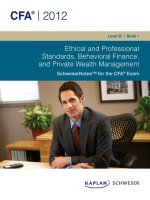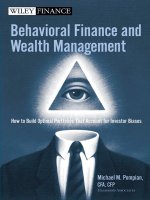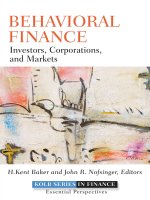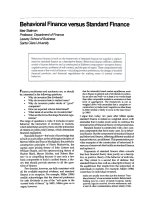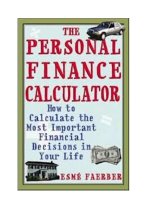R06 the behavioral finance perspective
Bạn đang xem bản rút gọn của tài liệu. Xem và tải ngay bản đầy đủ của tài liệu tại đây (126.62 KB, 35 trang )
Reading 6
The Behavioral Finance Perspective
www.irfanullah.co
Graphs, charts, tables, examples, and figures are copyright 2014, CFA Institute. Reproduced
and republished with permission from CFA Institute. All rights reserved.
1
Contents
• Introduction
• Behavioral Versus Traditional Perspectives
• Decision Making
• Perspectives on Market Behavior and Portfolio Construction
www.irfanullah.co
2
1. Introduction
Traditional finance models people as ‘rational’
Behavioral finance models people as ‘normal’
www.irfanullah.co
3
2. Behavioral vs. Traditional Perspectives
Traditional (Standard, Theoretical) Finance
• Individuals are risk-averse and utility
maximizing
• Modigliani and Miller’s arbitrage
principles
• Markowitz’s portfolio principles
• CAPM
• Option Pricing Theory
Behavioral Finance
• Based on observed investor and
market behavior
• Challenges rational investor
assumption
• Challenges efficient market hypothesis
• Behavioral finance micro (BFMI)
– Cognitive errors
– Emotional biases
• Behavioral finance macro (BFMA)
www.irfanullah.co
4
2.1 Traditional Finance Perspectives on Individual
Behavior
Rational investors: Make decisions consistent with utility theory
Revise expectations using Bayes formula
Utility Theory: Investors maximize utility or happiness
Completeness
Transitivity
Independence
Continuity
www.irfanullah.co
5
Bayes Formula
Example 1
www.irfanullah.co
6
Rational Economic Man (REM) will try to obtain highest possible utility given:
Budget Constraints
Information
He will only consider personal utility
Risk Aversion
Utility (U)
Exhibit 2
Wealth (W)
www.irfanullah.co
7
2.2 Behavioral Finance Perspectives on Individual
Behavior
Challenges to REM
Human behavior also depends on fear, love, hate, pleasure and pain?
Inner conflicts Prioritizing short-term vs. long-term aspirations
Do we really have perfect information Bounded rationality
www.irfanullah.co
8
Utility Maximization and Counterpoint
Exhibit 3
Counterpoint:
Do normal people define mathematical equations and draw curves to determine optimal tradeoff?
What about risk aversion, size of payout
What about exogenous factors such as state of the economy
www.irfanullah.co
9
Attitude Towards Risk
Traditional view:
Behavioral view:
Risk evaluation is reference dependent
Risk seeker for some for some levels of wealth
Lottery tickets
Exhibit 4: Double Inflection Utility Function
Utility (U)
Income (Z)
www.irfanullah.co
10
2.3 Neuro-economics
Explain how humans make economic decisions
It relies on multiple disciplines:
Nero-science: uses images of brain activity
Psychology
Economics
www.irfanullah.co
11
www.irfanullah.co
12
3. Decision Making
Decision Theory
Bounded Rationality
Prospect Theory
www.irfanullah.co
13
3.1 Decision Theory
Estimate values
Probability
Expected Value
Make optimal decision
Evaluate other
uncertainties
www.irfanullah.co
14
3.2 Bounded Rationality
Relax assumption that perfect information is available
Recognize that individuals lack cognitive skills to make optimal decisions
Available information
Satisfy + suffice Satisfice
Heuristics
Adequate Decisions
(not necessarily optimal)
Example 2
www.irfanullah.co
15
www.irfanullah.co
16
3.3 Prospect Theory
Alternative to expected utility theory
How do individuals evaluate potential losses and gains
Framing: How prospects (alternatives) are perceived based on their framing
Evaluation: Evaluate and decide
Framing or Editing Phase
Alternatives ranked according to heuristic selected by decision maker
How is this different from expected utility theory?
www.irfanullah.co
17
Six operations in the editing process (representative, Note 16):
Codification: We perceive outcomes as gain/losses rather than final wealth
Combination: Prospects simplified by combining probabilities of similar events
Segregation: Riskless component separated from risky component
Applied to
each
prospect
Cancellation: Discard common probability events
Simplification: Round off
Detection of Dominance: Items that are strictly dominated are rejected
www.irfanullah.co
Applied to
two or more
prospects
18
Different choices framed differently inconsistent preferences Isolation Effect
Gamble A: 25% $3,000 and 75% $0
65% selected Gamble B
Gamble B: 20% $4,000 and 80% $0
Next we look at 2-stage gamble:
75% chance of moving to second stage; 25% change of being rejected
Gamble C: 100% $3,000
78% selected Gamble C
Gamble D: 80% $4,000 and 20% $0
www.irfanullah.co
19
Evaluation Phase
People compute utility based on potential outcomes and respective probabilities
U=
Exhibit 5
People are loss-averse, not risk-averse
www.irfanullah.co
20
Would you take this gamble?
50% Probability Win $150
50% Probability Lose $100
Most people reject gamble with equal win/loss chance
… unless possible win is at least twice the possible loss
What if change to wealth was less than $100
What about:
100% Lose $100
OR
50% Probability Win $50
50% Probability Lose $200
Different attitudes to gains and losses
www.irfanullah.co
21
Prospect theory explains apparent deviations in decision making from the
rational decisions of traditional finance
People…
Overweight low probabilities
Underweight high probabilities
Are loss-average rather than risk averse
www.irfanullah.co
22
www.irfanullah.co
23
4. Perspectives on Market Behavior and Portfolio
Construction
Traditional Perspectives on Market Behavior
Traditional Perspectives on Portfolio Construction
Alternative Models of Market Behavior
www.irfanullah.co
24
4.1 Traditional Perspectives on Market Behavior
Efficient Market Hypothesis:
Markets fully, accurately, and instantaneously incorporate all available information into
market prices
Weak Form
Semi-Strong Form
Exhibit 7
www.irfanullah.co
25

